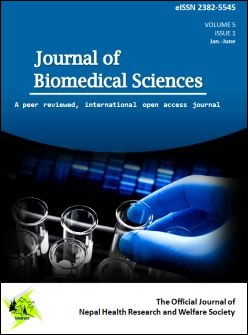Variations in levels of selected micronutrients during malaria infection
A study from Ado-Ekiti, Ekiti, Nigeria
DOI:
https://doi.org/10.3126/jbs.v5i1.22118Keywords:
Copper, iron, magnesium, malaria, micronutrients, zincAbstract
Background Malaria infection has been a global issue most especially in tropical and subtropical regions. Disease progression to severe malaria as a result of alteration in micronutrients could worsen the illness. The study aimed to determine whether there are variations in the levels of selected micronutrients (Iron, copper, magnesium, and zinc), malaria parasite density and packed cell volume (PCV) during malaria infection.
Material and methods A total of one hundred young adults between the ages of eighteen and twenty two years were investigated. Blood samples were collected from fifty malaria subjects and fifty apparently non-infected subjects. Malaria detection was by microscopy while the parasite density was estimated using WHO standard procedure. Analysis of selected micronutrients (copper, iron, magnesium and zinc) was carried out using direct measurement on atomic absorption spectrophotometer and PCV was estimated using Micro-haematocrit method.
Results The results showed that the levels of the micronutrients were significantly higher (p<0.05) in malaria subjects compared with controls. Significant positive relationships between copper, magnesium and zinc were found at p<0.01 and p<0.05.
Conclusion The study concluded that there are significant variations in the levels of the micronutrients during malaria infection.
Downloads
Downloads
Published
How to Cite
Issue
Section
License
This license enables reusers to distribute, remix, adapt, and build upon the material in any medium or format, so long as attribution is given to the creator. The license allows for commercial use.




